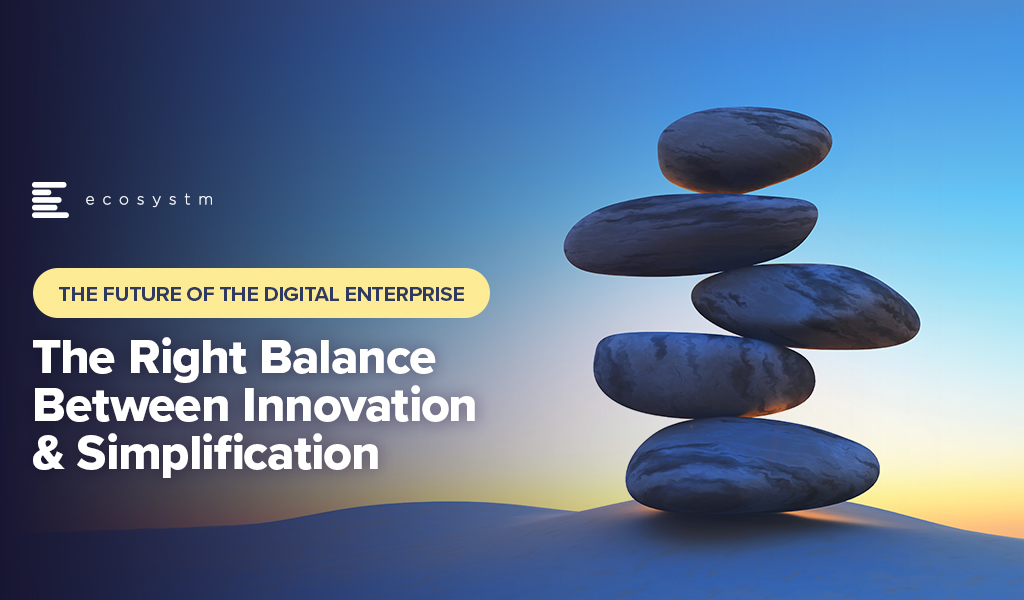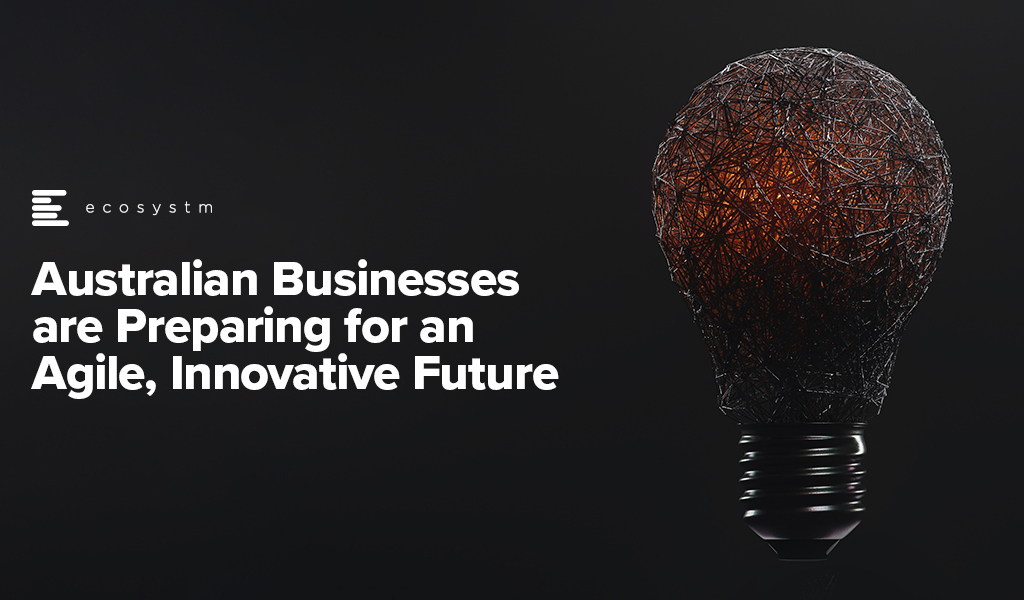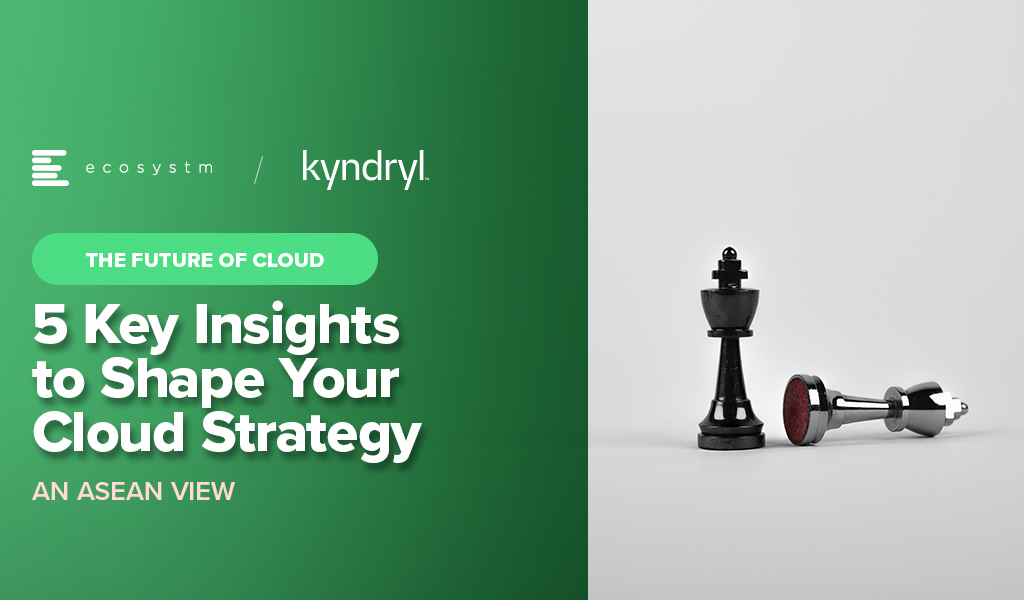Southeast Asia has evolved into an innovation hub with Singapore at the centre. The entrepreneurial and startup ecosystem has grown significantly across the region – for example, Indonesia now has the 5th largest number of startups in the world.
Organisations in the region are demonstrating a strong desire for tech-led innovation, innovation in experience delivery, and in evolving their business models to bring innovative products and services to market.
Here are 5 insights on the patterns of technology adoption in Southeast Asia, based on the findings of the Ecosystm Digital Enterprise Study, 2022.
- Data and AI investments are closely linked to business outcomes. There is a clear alignment between technology and business.
- Technology teams want better control of their infrastructure. Technology modernisation also focuses on data centre consolidation and cloud strategy
- Organisations are opting for a hybrid multicloud approach. They are not necessarily doing away with a ‘cloud first’ approach – but they have become more agnostic to where data is hosted.
- Cybersecurity underpins tech investments. Many organisations in the region do not have the maturity to handle the evolving threat landscape – and they are aware of it.
- Sustainability is an emerging focus area. While more effort needs to go in to formalise these initiatives, organisations are responding to market drivers.
More insights into the Southeast Asia tech market below.
Click here to download The Future of the Digital Enterprise – Southeast Asia as a PDF

Life never gets any easier for the digital and information technology teams in organisations. The range and reach of the different technologies continue to open new opportunities for organisations that have the foresight and strategy to chase them. Improving offers for existing customers and reaching new segments depend on the organisation’s ability to innovate.
But the complexity of the digital ecosystem means this ability to innovate will be heavily constrained, causing improvements to take longer and cost more in many cases. Addressing the top business priorities expressed in the Ecosystm Digital Enterprise Study, 2022, will need tech teams to look to simplify as well as add features.
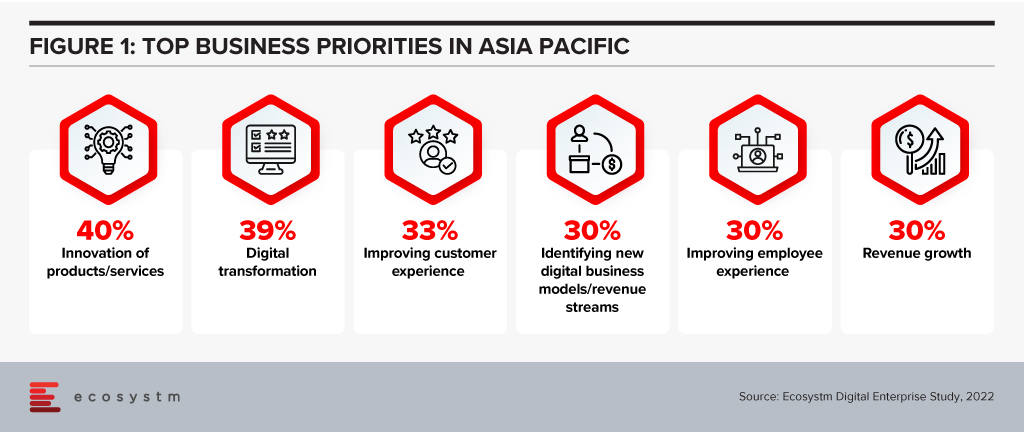
Complexity is Not Just an IT Issue
Many parts of an organisation have been making decisions on implementing new digital capabilities, particularly those involved in remote working. Frequently, the IT organisation has not been involved in the selection, implementation and use of these new facilities.
The number of start-up organisations delivering SaaS has continued to explode. A particular area has been the expansion of co-creation tools used by teams to deliver outcomes. In many cases, these have been introduced by enthusiastic users looking to improve their immediate working environment without the understanding of single-sign-on requirements, security and privacy of information or the importance of backup and business continuity planning.
SaaS tools such as Notion, monday.com and ClickUp (amongst many, many others), are being used to coordinate and manage teams across organisations of all sizes. While these are all cloud services, the support and maintenance of them ultimately will fall to the IT organisation. And they won’t be integrated at all with the tools the IT organisation uses to manage and improve user experience.
Every new component adds to the complexity of the tech environment – but with that complexity comes increased dependencies between components, which slows an organisation’s ability to adapt and evolve. This means each change needs more work to deliver, costs increase, and it takes longer to deliver value.
And this increasing complexity causes further problems with cybersecurity. Without regular attention, legacy systems will increase the attack surface of organisations, making it easier to compromise an organisation’s environment. At a recent executive forum with CISOs, attendees rated the risks caused by their legacy systems as their most significant concern.
An organisation’s leadership needs to both simplify and advance their organisation’s digital capabilities to remain competitive. This balance should not be left to the IT organisation to achieve as they will not be able to deliver both without wider support and recognition of the problems.
Discriminate on Differentiating Skills
One thing we can be sure of is that we won’t be able to employ all the skills we need for our future capabilities. We are not training enough people in the skills that we need now and for the future, and the range of technologies continues to expand, increasing the number of skills that we will need to keep an organisation running.
Most organisations are not removing or replacing ageing systems, preferring to keep them running at an apparently low cost. Often these legacy systems are fully depreciated, have low maintenance costs and have few changes made to them, as other areas of the organisation offer better investment options. But this also means that the old skills remain necessary.
So organisational leaders are adding new skills requirements on top of old, with the older skills being less attractive with so many new languages, frameworks and databases becoming available. Wikipedia has a very long list of languages that have been developed over the years. Some from the 1950s, like FORTRAN and LISP, continue to be used today.
Organisations will not be in a position to employ all the skills it needs to implement, develop and maintain for its digital infrastructure and applications. The choice is going to be which skills are most important to an organisation. This selection needs to be very discriminating and focus on differentiating skills – those that really make a difference within your ecosystem, particularly for your customers and employees.
Organisations will need a great partner who can deliver generic skills and more services. They will have better economies of scale and skill and will free management to attend to those things most important to customers and employees.
Hybrid Cloud has an Edge
Almost every organisation has a hybrid cloud environment. This is not a projection – it has already happened. And most organisations are not well equipped to deal with this situation.
Organisations may not be aware that they are using multiple public clouds. Many of the niche SaaS applications used by an organisation will use Microsoft Azure, AWS or GCP, so it is highly likely organisations are already using multiple public clouds. Not to mention the offerings from vendors such as Oracle, Salesforce, SAP and IBM. IT teams need to be able to monitor, manage and maintain this complex set of environments. But we are only in the early stages of integrating these different services and systems.
But there is a third leg to this digital infrastructure stool that is becoming increasingly important – what we call “the Edge” – where applications are deployed as part of the sensors that collect data in different environments. This includes applications such as pattern recognition systems embedded in cameras so that network and server delays cannot affect the performance of the edge systems. We can see this happening even in our homes. Google supports their Nest domestic products, while Alexa uses AWS. Not to mention Amazon’s Ring home security products.
With the sheer number of these edge devices that already exist, the complexity it adds to the hybrid environment is huge. And we expect IT organisations to be able to support and manage these.
Simplify, Specialise, Scale
The lessons for IT organisations are threefold:
- Simplify as much as possible while you are implementing new features and facilities. Retiring legacy infrastructure elements should be consistently included in the IT Team objectives. This should be done as part of implementing new capabilities in areas that are related to the legacy.
- Specialise in the skills that are the differentiators for your organisation with its customers and employees. Find great partners who can provide the more generic skills and services to take this load off your team.
- Scale your hybrid management environment so that you can automate as much of the running of your infrastructure as possible. You need to make your IT Team as productive as possible, and they will need power tools.
For IT vendors, the lessons are similar.
- Simplify customer offers as much as possible so that integration with your offering is fast and frugal. Work with them to reduce and retire as much of their legacy as possible as you implement your services. Duplication of even part of your offer will complicate your delivery of high-quality services.
- Understand where your customers have chosen to specialise and look to complement their skills. And consistently demonstrate that you are the best in delivering these generic capabilities.
- Scale your integration capabilities so that your customers can operate through that mythical single pane of glass. They will be struggling with the complexities of the hybrid infrastructure that include multiple cloud vendors, on-premises equipment, and edge services.

–
Businesses in Australia have come a long way over the past few years in digitising their processes and capabilities. In early 2020 – as the pandemic swept across the globe – nearly every business began to understand the challenges that lay ahead in digitising their organisation to meet the needs of fully remote employees and customers. Teams all across the business started to plug holes, reshape processes and deploy new technology capabilities to quickly meet these changing needs. This work continued over the next few years to the point now that most businesses in Australia have fully digital front-ends.
But as businesses move to “COVID normal” they are looking to the next opportunity. Digitising existing processes isn’t enough – they are starting to accelerate their innovation to create entirely new digitally native products and services. Growth by selling more of what they make is being replaced by a desire to grow into new markets, new products and new services. Business innovation has leapt back onto the agenda – and the ability to innovate at pace will define success in this new era.
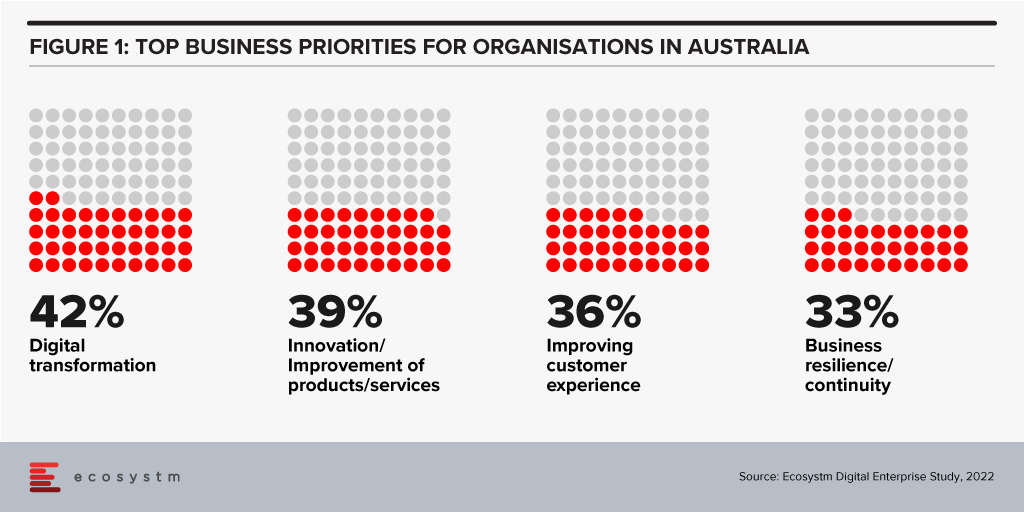
Improving IT Operations is a Major Priority for Tech Leaders in Australia
At the same time, technology leaders and their teams are dealing with technical debt and process complexity brought on by two years of accelerated and unplanned technology implementations. There is an urgent need to modernise IT Operations to better manage the growing number and complexity of digital systems. With the increasing importance of digital services to business, the Service Management and Tech Operations functions need increased investment, better processes, and greater automation to find and fix technology issues to minimise the impact of these issues on customer and employee outages.
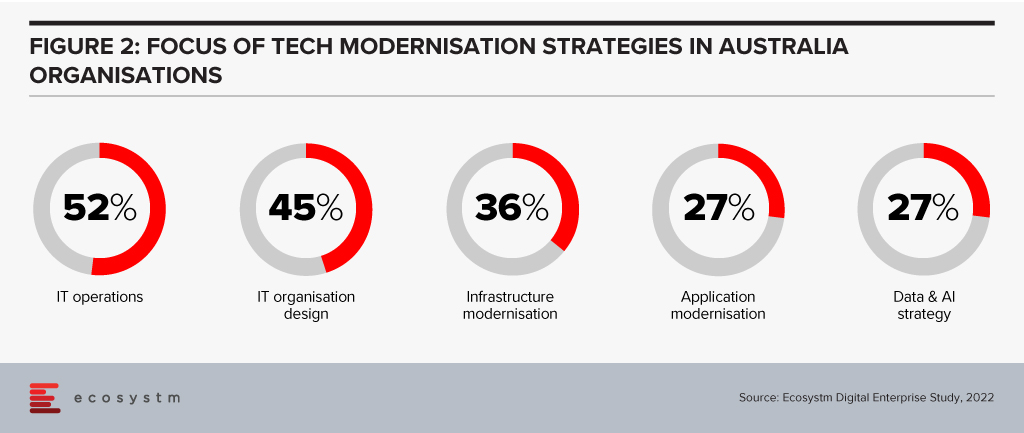
The Skills Crisis is Real – and Not Going Away Soon
The challenge today is to drive this important change while faced with the tech skills shortage. IT has not been spared the struggles that come with a low unemployment market – but often many of the Employee Experience initiatives designed to improve employee retention and loyalty are not designed with the tech team in mind. The demand for tech skills is from the lowest to the highest levels – from level 1 helpdesk operators to security, coding, cloud, and system management professionals – tech leaders are finding it very difficult to find and keep good staff.
Hybrid Cloud is Gaining Traction in Australia
As tech leaders design the technology team and architecture that will help to drive their business forward and enable the agile, innovative future that the business leaders imagine, it is becoming clear that the hybrid cloud will play an increasingly important role in this future. While the drive to public cloud is real – there is an increasing recognition that some applications will remain in private cloud environments and therefore they need to manage a multi-cloud world. Australian businesses have embraced hybrid cloud management platforms to manage their many cloud investments – both public and private – and help the business deliver new digital services at pace.
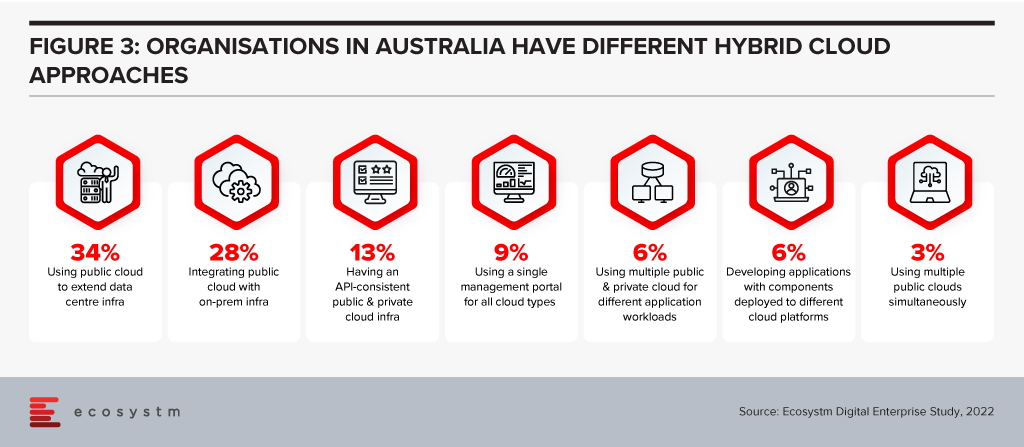
Tech Leaders Need to Perform a Balancing Act
The need to deploy new digital services, continuously improve them, make them always available, ensure they are running in the best environment, deliver automation and AI initiatives using great data – while finding and keeping the skills the tech team needs – are the real challenges that IT leaders face today. Finding the right balance between investment, automation, skills, governance, security, speed and agility (amongst many other factors) is the never-ending job of the CIO – it is just more crucial than ever that they get this right, as the ability of the business to survive and thrive in this new era of innovation and agility is at stake.

Organisations in Australia and New Zealand (ANZ) are focusing their digital transformation efforts on continued innovation in the experiences they deliver to their customers and employees.
Innovation has been at the core of organisations’ survival strategies – now it will be the means to gain competitive advantage and is getting prioritised over resiliency, business continuity and compliance.
Here are 5 insights on where ANZ organisations are headed in the tech priorities and investments, based on the findings of the Ecosystm Digital Enterprise Study, 2022.
- Tech Teams in ANZ are restructuring after a two-year struggle and as they face skills shortage.
- Tech investments are focusing on experience and digital workplace and customer experience technologies are seeing continued growth.
- Hybrid cloud investments are focused on augmenting existing infrastructure – whether public or on-prem
- Sales & Marketing are leveraging data & AI solutions the most; IT Ops and SecOps will see un uptick in 2023
- Cybersecurity practices are not evolving fast enough with only 9% of organisations having implemented Zero Trust
More insights into the ANZ tech market below.
Click here to download The Future of the Digital Enterprise – Australia & New Zealand as a PDF

Digital transformation has been a key company objective over the last two years – and more than a third of enterprises in ASEAN have it as their key business priority in 2022-23. They are aiming to be agile and digital organisations – with access to real-time data insights at their core.
Businesses have learned that their technology systems need to be scalable, accessible, easy to manage, fast to deploy and cost effective. Cloud infrastructure, platforms and software has become key enablers of business agility and innovation.
But the expansion of cloud applications has also seen an infrastructure and applications sprawl – which makes it essential for organisation to re-evaluate their cloud strategy.
Here are 5 insights that will help you shape your Cloud Strategy.
- Technology Change Management. Your cloud strategy must define the infrastructure and data architecture, security and resiliency measures, the technology environment management model, and IT operations.
- Building Scalable Enterprises. Focus on seamless access to all organisational data, irrespective of where they are generated (enterprise systems, IoT devices or AI solutions) and where they are stored (public cloud, on-premises, Edge, or co-location facilities).
- A Hybrid Multicloud Environment. For a successful hybrid multi cloud environment, keep a firm eye on hybrid cloud management, a suitable FinOps framework that balances performance and cost, and integration.
- A Technology-Neutral Approach. Partnering with a technology-neutral cloud services provider that leverages the entire tech ecosystem, will be critical.
- “Hybrid Cloud” Can Mean Many Things. Work with a cloud services partner, that has broad and deep capabilities across multiple hyperscalers and is able to address the unique requirements of your organisation.
Read on for more insights
Download 5 Key Insights to Shape Your Cloud Strategy – An ASEAN View as a PDF

As the leader of the tech team, CIOs are working through many different strategies and initiatives to drive new digital initiatives and improve existing ones. They are often pulled into new initiatives by business leaders and have to make hard decisions on how to support a business that is increasingly digitalised.
But there are five initiatives that all CIOs should have on their list for 2022 as they will deliver impactful results quickly and will make future investments more manageable and reliable.
In 2022, these 3 technology investments will give you a fast start:
- AIOps. This will be an easy business case to build if you evaluate the benefits
- Hybrid Cloud Management. Even if your business is racing towards the public cloud, you will have some hybrid cloud services.
- Federated Data Management. Because your infrastructure and applications will be hybrid, your data needs to be too.
These strategic initiatives will also be crucial this year:
- Resolve technical debt. Improve architectures and increase agility.
- Improve Talent Recruitment and Employee Retention. Be aware that the “great resignation” is a reality
Click here to download 5 IT Initiatives to Jumpstart Your Digital Business in 2022 as a PDF.

Cities worldwide have been facing unexpected challenges since 2020 – and 2022 will see them continue to struggle with the after-effects of COVID-19. However, there is one thing that governments have learnt during this ongoing crisis – technology is not the only aspect of a Cities of the Future initiative. Besides technology, Cities of the Future will start revisiting organisational and institutional structures, prioritise goals, and design and deploy an architecture with data as its foundation.
Cities of the Future will focus on being:
- Safe. Driven by the ongoing healthcare crisis
- Secure. Driven by the multiple cyber attacks on critical infrastructure
- Sustainable. Driven by citizen consciousness and global efforts such as the COP26
- Smart. Driven by the need to be agile to face future uncertainties
Read on to find out what Ecosystm Advisors, Peter Carr, Randeep Sudan, Sash Mukherjee and Tim Sheedy think will be the leading Cities of the Future trends for 2022.
Click here to download Ecosystm Predicts: The Top 5 Trends for Cities of the Future in 2022

On 4 November Kyndryl completed the spin-off from IBM and began trading as an independent company on the New York Stock Exchange. It is effectively a USD 19 Billion start-up, and the industry will be tracking its journey keenly. Kyndryl has the ability to disrupt markets as it reinvents its business to embrace growth areas and help clients through their tech-led transformations.
Ecosystm Analysts Darian Bird, Peter Carr, Sash Mukherjee, Tim Sheedy, Ullrich Loeffler, and Venu Reddy comment on Kyndryl’s strategy going forward and the associated opportunities.
To download this Vendorsphere as a pdf for offline use, please click here.
AI has become intrinsic to our personal lives – we are often completely unaware of technology’s influence on our daily lives. For enterprises too, tech solutions often come embedded with AI capabilities. Today, an organisation’s ability to automate processes and decisions is often dependent more on their desire and appetite for tech adoption, than the technology itself.
In 2022 the key focus for enterprises will be on being able to trust their Data & AI solutions. This will include trust in their IT infrastructure, architecture and AI services; and stretch to being able to participate in trusted data sharing models. Technology vendors will lead this discussion and showcase their solutions in the light of trust.
Read what Ecosystm analysts, Darian Bird, Niloy Mukherjee, Peter Carr and Tim Sheedy think will be the leading Data & AI trends in 2022.
Click here to download Ecosystm Predicts: The Top 5 Trends for Data & AI in 2022 as PDF













